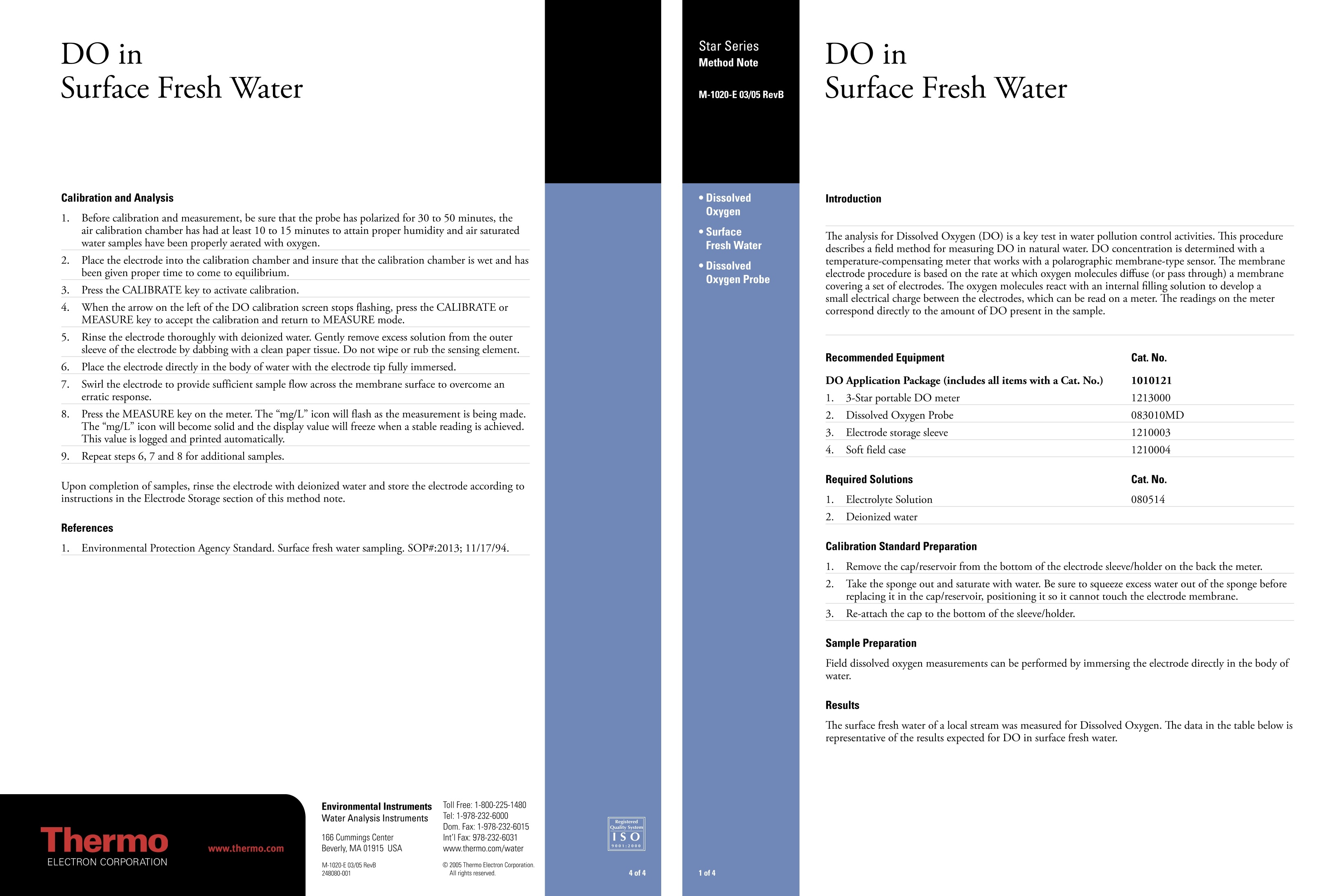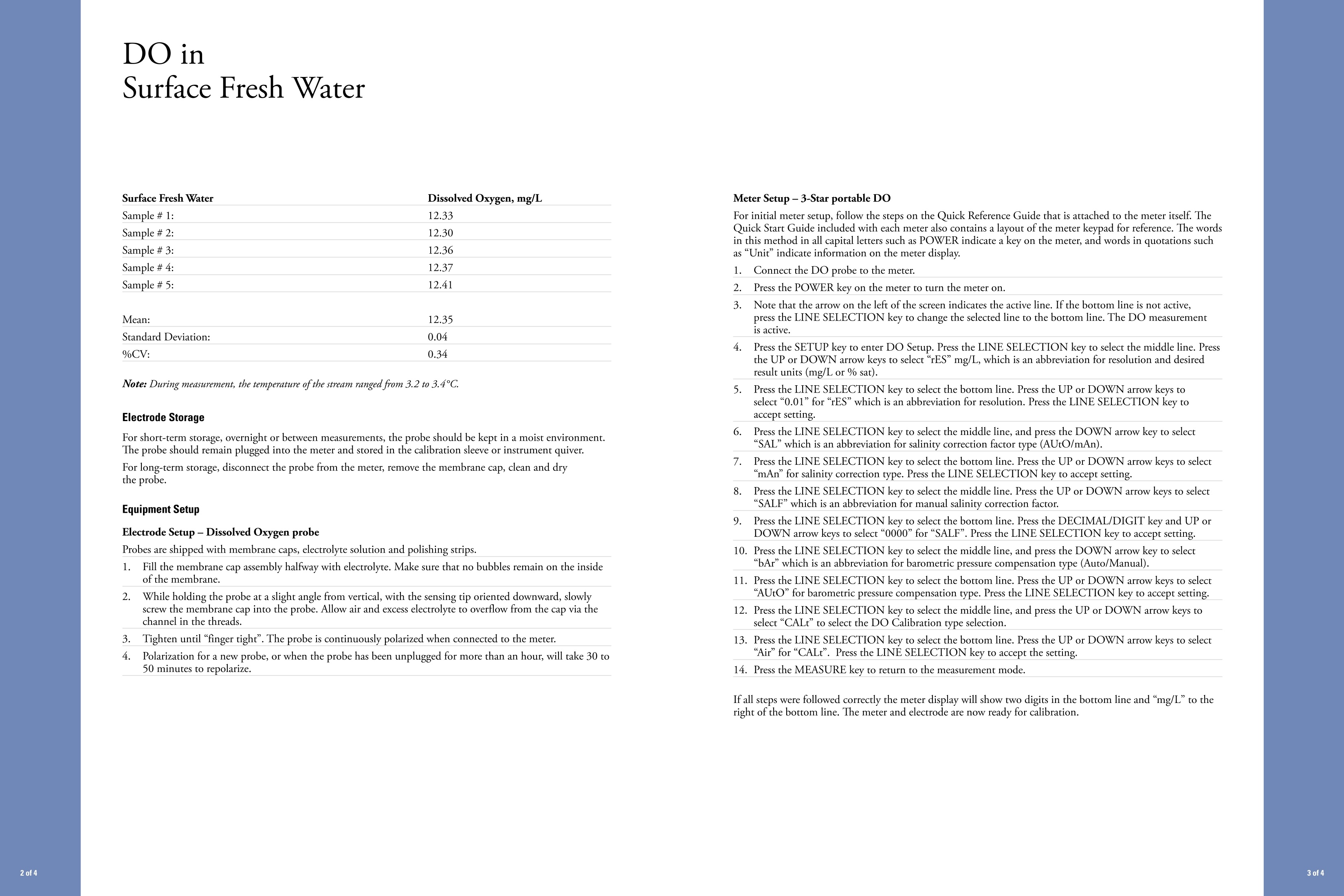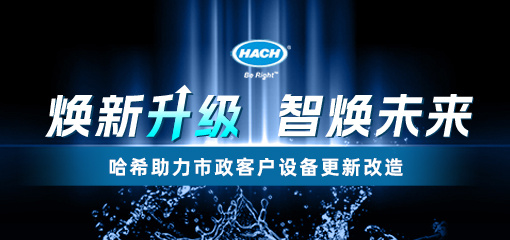
本文章详细介绍了地表水中溶解氧的测定,包括校准液、水样的准备,校准和测量过程,以及电极和仪表的维护等内容。
方案详情

DO inSurface Fresh Water DO inSurface Fresh Water Star SeriesMethod Note M-1020-E 03/05RevB Calibration and Analysis ·Dissolved Introduction 1. Before calibration and measurement, be sure that the probe has polarized for 30 to 50 minutes, theair calibration chamber has had at least 10 to 15 minutes to attain proper humidity and air saturatedwater samples have been properly aerated with oxygen. Oxygen ·Surface 2. Place the electrode into the calibration chamber and insure that the calibration chamber is wet and hasbeen given proper time to come to equilibrium. Fresh Water·DissolvedOxygen Probe 3. Press the CALIBRATE key to activate calibration. 4.When the arrow on the left of the DO calibration screen stop flashing, press the CALIBRATE orMEASURE key to accept the calibration and return to MEASURE mode. The analysis for Dissolved Oxygen (DO) is a key test in water pollution control activities. This proceduredescribes a field method for measuring DO in natural water. DO concentration is determined with atemperature-compensating meter that works with a polarographic membrane-type sensor. The membraneelectrode procedure is based on the rate at which oxygen molecules diffuse (or pass through) a membranecovering a set of electrodes. The oxygen molecules react with an internal filling solution to develop asmall electrical charge between the electrodes, which can be read on a meter.The readings on the metercorrespond directly to the amount of DO present in the sample. 5.Rinse the electrode thoroughly with deionized water. Gently remove excess solution from the outersleeve of the electrode by dabbing with a clean paper tissue. Do not wipe or rub the sensing element. 6.Place the electrode directly in the body of water with the electrode tip fully immersed. 7S.wirl the electrode to provide sufficient sample flow across the membrane surface to overcome anerratic response. 8.P1ress the MEASURE key on the meter. The “mg/L”icon will flash as the measurement is being made.The“mg/L" icon will become solid and the display value will freeze when a stable reading is achieved.This value is logged and printed automatically. 9. Repeat steps 6, 7 and 8 for additional samples. Upon completion of samples, rinse the electrode with deionized water and store the electrode according toinstructions in the Electrode Storage section of this method note. Cat. No. DO Application Package (includes all items with a Cat. No.) 1010121 1. 3-Star portable DO meter 1213000 2. Dissolved Oxygen Probe 083010MD 3. Electrode storage sleeve 1210003 4. Soft field case 1210004 Required Solutions Cat. No. 1. Electrolyte Solution 080514 2. Deionized water References 1. Environmental Protection Agency Standard. Surface fresh water sampling. SOP#:2013;11/17/94 Calibration Standard Preparation 1.. Remove the cap/reservoir from the bottom of the electrode sleeve/holder on the back the meter. 2. Take the sponge out and saturate with water. Be sure to squeeze excess water out of the sponge beforereplacing it in the cap/reservoir, positioning it so it cannot touch the electrode membrane.3. Re-attach the cap to the bottom of the sleeve/holder. Sample Preparation Field dissolved oxygen measurements can be performed by immersing the electrode directly in the body ofwater. Results ( The surface fresh water of a l ocal stream w as measured fo r Di ss olved Oxygen. The d a ta in th e table below isrepresentative of the results expected for DO in surface fresh water. ) ( Environmental Instruments Water Analysis Instruments ) ( 1 66 Cummings C enterBeverly, MA 01915 USA M-1 0 20-E0 3 /05 RevE248080 - 0 0 1 ) Toll Free: 1-800-225-1480Tel:1-978-232-6000Dom. Fax:1-978-232-6015Intl Fax:978-232-6031www.thermo.com/waterO 2005 Thermo Electron Corporation RegisteredIs o9001:2000 All rights reserved Note: During measurement, the temperature of the stream ranged from 3.2 to 3.4℃. Electrode Storage For short-term storage, overnight or between measurements, the probe should be kept in a moist environment.The probe should remain plugged into the meter and stored in the calibration sleeve or instrument quiver.For long-term storage, disconnect the probe from the meter, remove the membrane cap, clean and drythe probe. Equipment Setup Electrode Setup-Dissolved Oxygen probe Probes are shipped with membrane caps, electrolyte solution and polishing strips. 1.Fill the membrane cap assembly halfway with electrolyte. Make sure that no bubbles remain on the insideof the membrane. 2. While holding the probe at a slight angle from vertical, with the sensing tip oriented downward, slowlyscrew the membrane cap into the probe. Allow air and excess electrolyte to overflow from the cap via thechannel in the threads. 3. Tighten until "finger tight". The probe is continuously polarized when connected to the meter. 4. Polarization for a new probe, or when the probe has been unplugged for more than an hour, will take 30 to50 minutes to repolarize. For initial meter setup, follow the steps on the Quick Reference Guide that is attached to the meter itself. TheQuick Start Guide included with each meter also contains a layout of the meter keypad for reference. The wordsin this method in all capital letters such as POWER indicate a key on the meter, and words in quotations suchas “Unit”indicate information on the meter display. 1. Connect the DO probe to the meter..2 Press the POWER key on the meter to turn the meter on. 3. Note that the arrow on the left of the screen indicates the active line. If the bottom line is not active,press the LINE SELECTION key to change the selected line to the bottom line. The DO measurementis active. 4. Press the SETUP key to enter DO Setup. Press the LINE SELECTION key to select the middle line. Pressthe UP or DOWN arrow keys to select “rES”mg/L, which is an abbreviation for resolution and desiredresult units (mg/L or % sat). 5 Press the LINE SELECTION key to select the bottom line. Press the UP or DOWN arrow keys toselect “0.01”for"rES”which is an abbreviation for resolution. Press the LINE SELECTION key toaccept setting. 6 Press the LINE SELECTION key to select the middle line, and press the DOWN arrow key to select“SAL”which is an abbreviation for salinity correction factor type (AUtO/mAn). 7. Press the LINE SELECTION key to select the bottom line. Press the UP or DOWN arrow keys to select“mAn for salinity correction type.Press the LINE SELECTION key to accept setting. 8 Press the LINE SELECTION key to select the middle line. Press the UP or DOWN arrow keys to select“SALF” which is an abbreviation for manual salinity correction factor. 9.Press the LINE SELECTION key to select the bottom line. Press the DECIMAL/DIGIT key and UP orDOWN arrow keys to select “0000”for“SALF”. Press the LINE SELECTION key to accept setting. 10. Press the LINE SELECTION key to select the middle line, and press the DOWN arrow key to select“bAr”which is an abbreviation for barometric pressure compensation type (Auto/Manual). 11. Press the LINE SELECTION key to select the bottom line. Press the UP or DOWN arrow keys to select“AUtO” for barometric pressure compensation type. Press the LINE SELECTION key to accept setting. 12. Press the LINE SELECTION key to select the middle line, and press the UP or DOWN arrow keys toselect “CALt”to select the DO Calibration type selection. 13. Press the LINE SELECTION key to select the bottom line. Press the UP or DOWN arrow keys to select“Air” for “CALt". Press the LINE SELECTION key to accept the setting. 14. Press the MEASURE key to return to the measurement mode. If all steps were followed correctly the meter display will show two digits in the bottom line and"mg/L"to theright of the bottom line. The meter and electrode are now ready for calibration. www.thermo.com ofof of of
确定


还剩1页未读,是否继续阅读?
赛默飞世尔环境与过程为您提供《环境水中有机物综合指标检测方案 》,该方案主要用于环境水(除海水)中有机物综合指标检测,参考标准--,《环境水中有机物综合指标检测方案 》用到的仪器有
相关方案
更多
该厂商其他方案
更多









